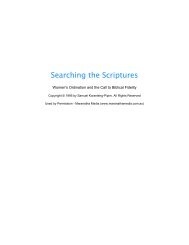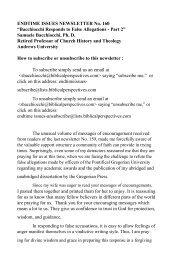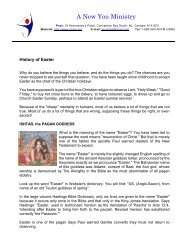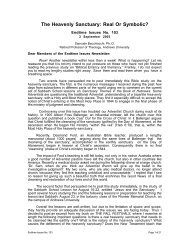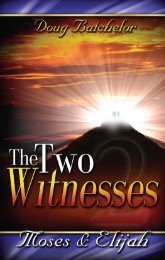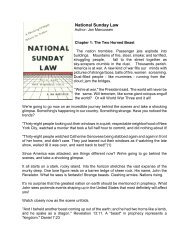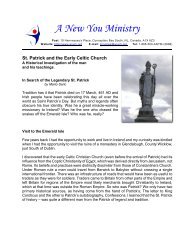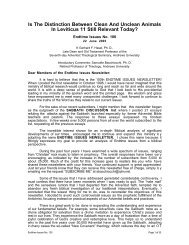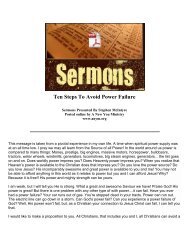Bible Readings for the Home Circleâ1914 - A New You Ministry
Bible Readings for the Home Circleâ1914 - A New You Ministry
Bible Readings for the Home Circleâ1914 - A New You Ministry
Create successful ePaper yourself
Turn your PDF publications into a flip-book with our unique Google optimized e-Paper software.
BIBLE READINGS<br />
“In which were offered both gifts and sacrifices.” Heb. 9:9.<br />
3. Besides <strong>the</strong> court, how many parts had this sanctuary<br />
“And <strong>the</strong> veil shall divide unto you between <strong>the</strong> holy place and <strong>the</strong><br />
most holy.” Ex. 26:33.<br />
4. What was in <strong>the</strong> first apartment, or holy place<br />
“For <strong>the</strong>re was a tabernacle made; <strong>the</strong> first, wherein was <strong>the</strong> candlestick,<br />
and <strong>the</strong> table, and <strong>the</strong> showbread; which is called <strong>the</strong> sanctuary.”<br />
Heb. 9:2. “And he put <strong>the</strong> golden altar in <strong>the</strong> tent of <strong>the</strong> congregation<br />
be<strong>for</strong>e <strong>the</strong> veil.” Ex. 40:26. See also Ex. 30:1–6.<br />
5. What was contained in <strong>the</strong> second apartment<br />
“And after <strong>the</strong> second veil, <strong>the</strong> tabernacle which is called <strong>the</strong> holiest of<br />
all; which had <strong>the</strong> golden censer, and <strong>the</strong> ark of <strong>the</strong> covenant overlaid<br />
round about with gold, wherein was . . . <strong>the</strong> tables of <strong>the</strong> covenant.” Heb.<br />
9:3, 4. See also Ex. 40:20, 21.<br />
6. By what name was <strong>the</strong> cover of <strong>the</strong> ark known<br />
“And thou shalt put <strong>the</strong> mercy-seat above upon <strong>the</strong> ark; and {239<br />
239} in<br />
<strong>the</strong> ark thou shalt put <strong>the</strong> testimony that I shall give <strong>the</strong>e.” Ex. 25:21.<br />
7. Where was God to meet with Israel<br />
“And <strong>the</strong>re I will meet with <strong>the</strong>e, and I will commune with <strong>the</strong>e from<br />
above <strong>the</strong> mercy-seat, from between <strong>the</strong> two cherubim which are upon <strong>the</strong><br />
ark of <strong>the</strong> testimony.” Verse 22.<br />
8. What was in <strong>the</strong> ark, under <strong>the</strong> mercy-seat<br />
“And He wrote on <strong>the</strong> tables, according to <strong>the</strong> first writing, <strong>the</strong> ten<br />
commandments. . . . And I turned myself and came down from <strong>the</strong> mount,<br />
and put <strong>the</strong> tables in <strong>the</strong> ark which I had made.” Deut. 10:4, 5.<br />
9. When did <strong>the</strong> priest minister in <strong>the</strong> first apartment of <strong>the</strong> sanctuary<br />
“Now <strong>the</strong>se things having been thus prepared, <strong>the</strong> priests go in continually<br />
into <strong>the</strong> first tabernacle, accomplishing <strong>the</strong> services.” Heb. 9:6, R.V.<br />
10. Who alone went into <strong>the</strong> second apartment, how often, and <strong>for</strong><br />
what purpose<br />
“But into <strong>the</strong> second went <strong>the</strong> high priest alone once every year, not<br />
without blood, which he offered <strong>for</strong> himself, and <strong>for</strong> <strong>the</strong> errors of <strong>the</strong><br />
people.” Verse 7.<br />
11. What were sinners desiring pardon instructed to do<br />
“And if any one of <strong>the</strong> common people sin through ignorance, while<br />
he doeth somewhat against any of <strong>the</strong> commandments of <strong>the</strong> Lord . . .<br />
<strong>the</strong>n he shall bring his offering, a kid of <strong>the</strong> goats, a female without blemish,<br />
<strong>for</strong> his sin which he hath sinned. And he shall lay his hand upon <strong>the</strong><br />
THE ATONEMENT IN TYPE AND ANTITYPE<br />
head of <strong>the</strong> sin-offering, and slay <strong>the</strong> sin-offering in <strong>the</strong> place of <strong>the</strong> burnt<br />
offering.” Lev. 4:27–29.<br />
NOTE.— According to this, if a man sinned in Israel, he violated one of<br />
<strong>the</strong> ten commandments that were in <strong>the</strong> ark under <strong>the</strong> mercy-seat.<br />
These commandments are <strong>the</strong> foundation of God’s government. To<br />
violate <strong>the</strong>m is to commit sin, and so become subject to death. 1 John<br />
3:4; Rom. 6:23. But <strong>the</strong>re was a mercy-seat reared above <strong>the</strong>se holy and<br />
just commandments. In <strong>the</strong> dispensation of His mercy, God grants <strong>the</strong><br />
sinner <strong>the</strong> privilege of confessing his sins, and. bringing a substitute<br />
to meet <strong>the</strong> demands of <strong>the</strong> law, and thus of obtaining mercy.<br />
12. What was done with <strong>the</strong> blood of <strong>the</strong> offering<br />
“And <strong>the</strong> priest shall take of <strong>the</strong> blood <strong>the</strong>reof with his finger, and put<br />
it upon <strong>the</strong> horns of <strong>the</strong> altar of burnt offering, and shall pour out all <strong>the</strong><br />
blood <strong>the</strong>reof at <strong>the</strong> bottom of <strong>the</strong> altar.” Verse 30. {240<br />
240}<br />
NOTE.— After a person discovered his sin by <strong>the</strong> law which demanded<br />
<strong>the</strong> death of <strong>the</strong> transgressor, he first brought his offering, <strong>the</strong>n he<br />
confessed his sin while laying his hands on <strong>the</strong> head of <strong>the</strong> victim,<br />
thus, in figure, transferring his sin to <strong>the</strong> victim; <strong>the</strong> victim was next<br />
slain in <strong>the</strong> court, or outer part of <strong>the</strong> sanctuary, and its blood put on<br />
<strong>the</strong> horns of <strong>the</strong> altar and poured at <strong>the</strong> foot of <strong>the</strong> altar. In this way<br />
sins were pardoned, and, in <strong>the</strong> typical service, transferred to <strong>the</strong> sanctuary.<br />
13. After <strong>the</strong> accumulation of <strong>the</strong> sins of <strong>the</strong> year in this way, what<br />
service took place on <strong>the</strong> tenth day of <strong>the</strong> seventh month of each<br />
year<br />
“And this shall be a statute <strong>for</strong>ever unto you: that in <strong>the</strong> seventh month,<br />
on <strong>the</strong> tenth day of <strong>the</strong> month, ye shall afflict your souls. . . . <strong>for</strong> on that<br />
day shall <strong>the</strong> priest make an atonement <strong>for</strong> you, to cleanse you, that ye<br />
may be clean from all your sins be<strong>for</strong>e <strong>the</strong> Lord.” Lev. 16:29, 30.<br />
14. How was <strong>the</strong> sanctuary itself to be cleansed, and how were <strong>the</strong><br />
sins of <strong>the</strong> people to be finally disposed of<br />
“And he [<strong>the</strong> high priest] shall take of <strong>the</strong> congregation of <strong>the</strong> children<br />
of Israel two kids of <strong>the</strong> goats <strong>for</strong> a sin-offering. . . . And he shall take <strong>the</strong><br />
two goats, and present <strong>the</strong>m be<strong>for</strong>e <strong>the</strong> Lord at <strong>the</strong> door of <strong>the</strong> tabernacle<br />
of <strong>the</strong> congregation. And Aaron shall cast lots upon <strong>the</strong> two goats, one lot<br />
<strong>for</strong> <strong>the</strong> Lord, and <strong>the</strong> o<strong>the</strong>r lot <strong>for</strong> <strong>the</strong> scapegoat.” Verses 5–8.<br />
NOTE.— The Hebrew word <strong>for</strong> scapegoat is Azazel. See margin of<br />
verse 8. It is used as a proper name, and, according to <strong>the</strong> opinion of<br />
<strong>the</strong> most ancient Hebrews and Christians, refers to Satan, or <strong>the</strong> angel<br />
who revolted and persisted in rebellion and sin.<br />
15. What was done with <strong>the</strong> blood of <strong>the</strong> goat upon which <strong>the</strong> Lord’s<br />
lot fell<br />
“Then shall he kill <strong>the</strong> goat of <strong>the</strong> sin-offering, that is <strong>for</strong> <strong>the</strong> people,




